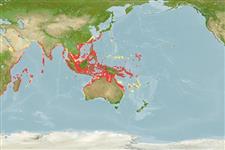Environment: milieu / climate zone / depth range / distribution range
Ecology
Marine; reef-associated; non-migratory; depth range 1 - 64 m, usually 4 - 30 m (Ref. 90102). Tropical; 32°N - 32°S, 29°E - 171°E (Ref. 5222)
Indo-West Pacific: Kenya to southern Mozambique eastward to the western Pacific. Reported from the Arafura Sea (Ref. 9819). Not reported from oceanic islands in the Indian Ocean, except for Aldabra, Comoros, Madagascar, and the Andaman and Lakshadweep islands. Unknown from the Red Sea, Persian Gulf, and from the islands of Micronesia except for Palau. Record from Rodriguez by Heemstra & Randall (1984, Ref. 3153) could not be verified and is probably erroneous (Ref. 33390).
Length at first maturity / Size / Weight / Age
Maturity: Lm 12.2, range 8 - ? cm
Max length : 30.0 cm TL male/unsexed; (Ref. 48635); max. reported age: 11 years (Ref. 45317)
Dorsal spines (total): 9; Dorsal soft rays (total): 15 - 17; Anal spines: 3; Anal soft rays: 8. Brownish to greenish grey with dusky vertical bands over the body. White margins and black sub-margins on the median fins (Ref. 48635). Preopercle rounded, very finely serrate; no enlarged spines at angle, lower edge fleshy; characterized further by having ctenoid scales on body including abdomen; greatest depth of body 2.6-3.1 in SL; rounded caudal fin; pelvic fins not usually reaching anus, 1.6-2.1 in head length (Ref. 90102).
Mainly a coastal species (Ref. 48635). Inhabits silty dead reefs in protected waters. May also be seen on live coral (Ref. 089707). Secretive (Ref. 37816). Feeds mainly on fish (Ref. 30531) and crustaceans (Ref. 089707). Courtship and pair spawning were observed by Donaldson (1989, Ref. 6900). Diandric protogynous hermaphrodite (Ref. 45317).
Life cycle and mating behavior
Maturities | Reproduction | Spawnings | Egg(s) | Fecundities | Larvae
Heemstra, P.C. and J.E. Randall, 1993. FAO Species Catalogue. Vol. 16. Groupers of the world (family Serranidae, subfamily Epinephelinae). An annotated and illustrated catalogue of the grouper, rockcod, hind, coral grouper and lyretail species known to date. Rome: FAO. FAO Fish. Synop. 125(16):382 p. (Ref. 5222)
IUCN Red List Status (Ref. 130435)
Threat to humans
Harmless
Human uses
Fisheries: subsistence fisheries; aquarium: commercial
Tools
Special reports
Download XML
Internet sources
Estimates based on models
Preferred temperature (Ref.
123201): 24.7 - 29.1, mean 28.1 °C (based on 1414 cells).
Phylogenetic diversity index (Ref.
82804): PD
50 = 0.5000 [Uniqueness, from 0.5 = low to 2.0 = high].
Bayesian length-weight: a=0.01288 (0.01049 - 0.01582), b=3.04 (3.01 - 3.07), in cm total length, based on LWR estimates for this species (Ref.
93245).
Trophic level (Ref.
69278): 4.1 ±0.6 se; based on diet studies.
Resilience (Ref.
120179): Medium, minimum population doubling time 1.4 - 4.4 years (tm=1-2).
Prior r = 0.38, 95% CL = 0.25 - 0.57, Based on 4 data-limited stock assessments.
Fishing Vulnerability (Ref.
59153): Low vulnerability (20 of 100).
Climate Vulnerability (Ref.
125649): Moderate vulnerability (40 of 100).
Nutrients (Ref.
124155): Calcium = 58.7 [34.2, 104.7] mg/100g; Iron = 0.613 [0.351, 1.150] mg/100g; Protein = 18.5 [16.6, 20.1] %; Omega3 = 0.175 [0.110, 0.277] g/100g; Selenium = 35.1 [19.2, 60.4] μg/100g; VitaminA = 169 [64, 524] μg/100g; Zinc = 0.846 [0.610, 1.373] mg/100g (wet weight); based on
nutrient studies.
